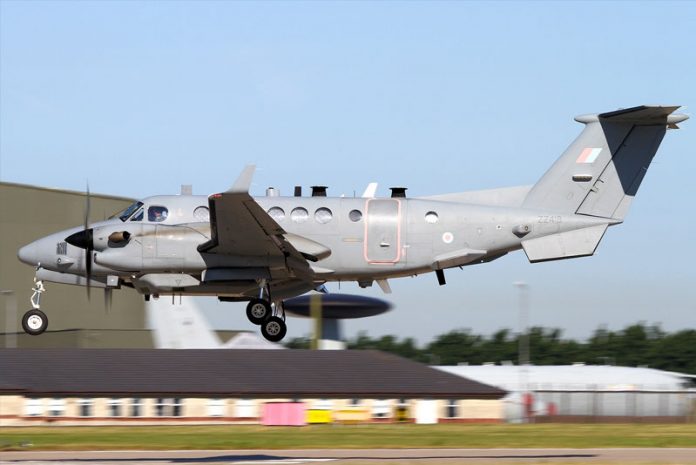
The Royal Air Force (RAF) is planning a fleet expansion, and major upgrade, of its Beechcraft Shadow-R1 ISR (Intelligence, Surveillance and Reconnaissance) aircraft.
The Shadow-R1 is a combined Communications Intelligence (COMINT) and Imagery Intelligence (IMINT) platform. These planes are highly recognisable thanks to several Very/Ultra High Frequency (V/UHF) and Satellite Communications (SATCOM) antennas on their dorsal fuselage. These are used to share the intelligence they collect with other users in the air and on the ground. This may include the sharing of intelligence in real time. Alongside the L3 Wescam MX-15 optronics system visible on the aircraft’s ventral fuselage it has a COMINT payload. Although not confirmed by the RAF or the United Kingdom’s Ministry of Defence the Shadow-R1 maybe equipped with L3’s Spydr combined IMINT/COMINT system which comprises L3’s Rio signals intelligence software, which can monitor a waveband of 20 megahertz/MHz to three gigahertz/GHz, according to the company. Rio can geo-locate emitters, displaying them on a ‘Google Earth’ style map. Once the source of these emissions is located, the MX-15 can be used to gather IMINT on the communications device’s user.
The upgrade is expected to add open architecture systems into the aircraft’s mission fit, presumably to allow the upgrade of its COMINT systems with software to the greatest extent possible as the aircraft goes through its service life. Other enhancements could see improvements to ensure that the aircraft can better share intelligence across its V/UHF radio and SATCOM links.
Sources close to the Shadow-R1 programme stated that the concept of operations for the aircraft was for RAF platforms such as the Boeing RC-135W Airseeker/Rivet Joint Signals Intelligence (SIGINT) collection aircraft, or the force’s Raytheon/Bombardier Sentinel-R1 battlefield surveillance aircraft, to initially detect potential targets. For this task the RC-135W can use its Automatic Electronic Emitter Location System and Multiple Communications Emitter Location System while the Sentinel-R1 can employ its ASTOR (Airborne Stand-off Radar) X-band (8.5GHz to 10.68GHz) airborne surveillance radar. Once a target is discovered, the Shadow-R1 could be tasked to take a closer look. The aircraft could use its COMINT package to detect the target’s emissions based on SIGINT sent by tactical datalink from these aircraft. Once in the target’s vicinity, the Shadow-R1 can record COMINT and IMINT of the target.
The RAF is planning to expand the six-strong fleet to eight aircraft. Delivery of these two additional aircraft is expected in 2023, Raytheon sources shared with Armada Analysis during this year’s Defence and Security Equipment International exhibition held in London in mid-September. All eight Shadow-R1s will have the same configuration with the six legacy aircraft being upgraded to the same status as the two new planes. The upgrade, the sources disclosed, will focus on improving the aircraft’s communications and its ability to share its intelligence with other users in the air and on the ground. Although the company declined to provide specific details, this could include expanding the bandwidth of the radios and SATCOM the aircraft currently uses. The new and upgraded platform will be designated the Shadow-R1 Mk.2. The upgrades should allow the aircraft to remain in service until at least 2030, the sources added. They continued that design work is expected to be completed by the end of the year, with upgrades and production of the two new aircraft commencing in 2020. Enhancements will be rolled onto the legacy aircraft via a series of block upgrades. These will serve to “improve agility and interconnectivity, while future-proofing the aircraft,” the sources emphasised.













